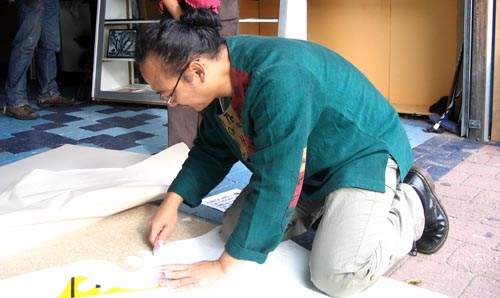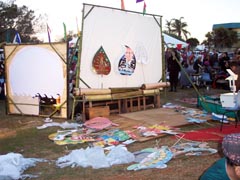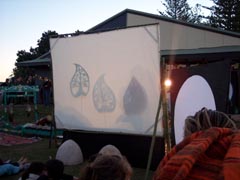Home | Vol 21 Table of Contents | Previous Issues | Contact Us: 07 55278753 / 0405463663 | Email: judybyronbay@yahoo.com
Who is Heri Dono ?
by Cynthia Webb
The contemporary artist Heri Dono, was born in West Java in 1960 and is one of the most acclaimed and most emulated artists in Indonesia. His works are in museums throughout the world and he has won major international prizes.

Heri Dono was one of the guests in Byron Bay for the upcoming FEHVA (Forty eight Hours of Visual Arts) FESTIVAL in collaboration with the Inspirasi Indonesian Arts Festival presented by The Australia Indonesia Arts Alliance and the Australia Indonesia Institute. Julie Ewington of the Queensland Art Gallery conducted an interview with Heri Dono on Sunday 2 July as part of the FEHVA program at the Byron Bay Community and Cultural Centre. The discussion was entitled “Communicating Art Across Cultures”.


Heri is in a strong position to know about this subject. He is one of Indonesia’s most widely known international contemporary artists. He has travelled the world participating in major exhibitions and prestigious biennales. His work has been seen in Shanghai, Venice, Vancouver, Tokyo, Kuala Lumpur, Singapore, Kwangju (Korea), Vienna, Berlin, New York, Sao Paulo, Australia, New Zealand, and Havana (Cuba) and throughout the world. He has been a regular participant in the Asia Pacific Triennial at the Queensland Art Gallery and is well known in Brisbane.
His work features paintings, installations, objects, performances and video art. Heri likes to use humour, irony, sarcasm, caricature, grotesque imagery and images of pop culture including adaptations of the superheroes, to make his art commentary on the world around him. He was influenced by comic books from an early age.
He studied the Indonesian traditional drama form the Wayang Kulit, and also uses wayang puppet figures in his work, often to obliquely refer to the political elite. His activities in Byron Bay included a collaborative process with local participants as part of the Indonesian Arts Camp held at the Byron Arts Factory. Heri shared his knowledge of shadow puppetry and performance art resulting in the finale performance for Inspirasi Art Festival held on17 July at Byron Peace Pole.
In 2004 the National Gallery of Indonesia, Jakarta honoured him, with a Heri Dono Retrospective Exhibition entitled “Who’s Afraid of Donosaurus?” The answer is, perhaps quite a few sections of Indonesian society, because some of Heri’s artistic comments were aimed at the education system (a work entitled “Fermentation of the Mind”), the religious establishment, (a work called “An Artist Who’s Afraid of Halalism”), and the art establishment, (a work entitled “An Artist Who’s Afraid of the Galleries Mafia”).
While Heri’s work often features strong social and political comment, he also has a contrasting deep appreciation of beauty, imagination and a desire for creative freedom. He likes to work in a collaborative way with friends and non-art workers, who help him construct the gadgets and machinery he uses in installations.
He is something of a dreamer and the world of his imagination is boundless. Here is where he is totally free. To express this side of his persona, he uses the symbol of angels. He has presented an installation, which features a small platoon of flying angels, suspended from the ceiling. Quaint little winged dolls with male genitals, wearing helmets. Wings outstretched, flying bravely on, expressing Heri’s hopes and dreams for himself and the human race. These inspiring little airmen greeted visitors to the last Asia Pacific Triennial in Brisbane as they entered the Queensland Art Gallery lobby.
Heri recently exhibited the angels in Berlin, in an exhibition entitled “About Beauty”, and he wrote: ‘Mind and imagination are always ahead of their time. To me angels stand for inspiration. No one can go beyond angels, who symbolize our freedom as human beings on earth. They may lead us on to all kinds of phenomena still unknown”.
For more information: www.fehva.com.